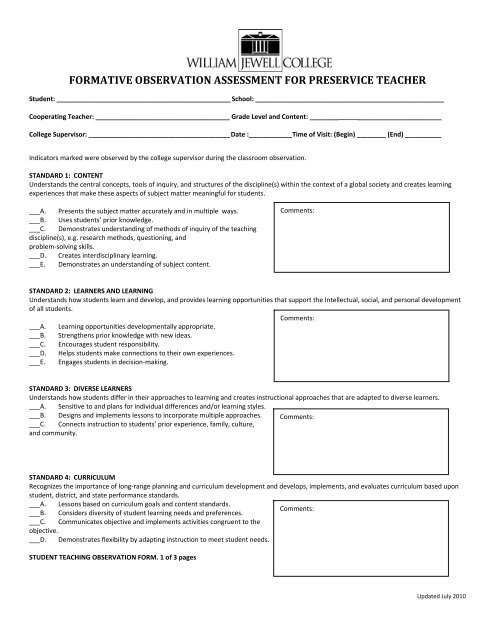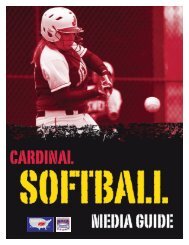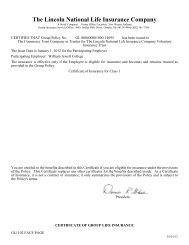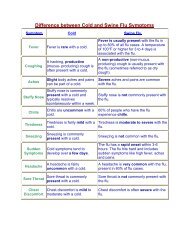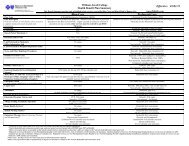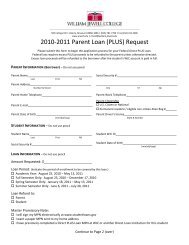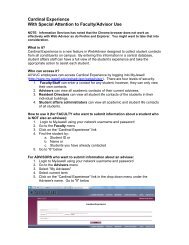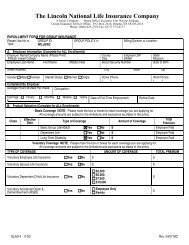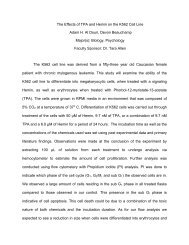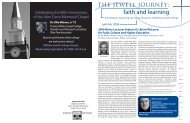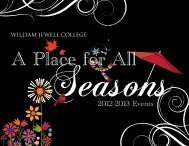formative observation assessment for preservice teacher
formative observation assessment for preservice teacher
formative observation assessment for preservice teacher
Create successful ePaper yourself
Turn your PDF publications into a flip-book with our unique Google optimized e-Paper software.
FORMATIVE OBSERVATION ASSESSMENT FOR PRESERVICE TEACHER<br />
Student: ________________________________________________ School: ____________________________________________________<br />
Cooperating Teacher: _____________________________________ Grade Level and Content: _____________________________________<br />
College Supervisor: _______________________________________ Date :____________Time of Visit: (Begin) ________ (End) __________<br />
Indicators marked were observed by the college supervisor during the classroom <strong>observation</strong>.<br />
STANDARD 1: CONTENT<br />
Understands the central concepts, tools of inquiry, and structures of the discipline(s) within the context of a global society and creates learning<br />
experiences that make these aspects of subject matter meaningful <strong>for</strong> students.<br />
___A. Presents the subject matter accurately and in multiple ways.<br />
___B. Uses students’ prior knowledge.<br />
___C. Demonstrates understanding of methods of inquiry of the teaching<br />
discipline(s), e.g. research methods, questioning, and<br />
problem‐solving skills.<br />
___D. Creates interdisciplinary learning.<br />
___E. Demonstrates an understanding of subject content.<br />
Comments:<br />
STANDARD 2: LEARNERS AND LEARNING<br />
Understands how students learn and develop, and provides learning opportunities that support the Intellectual, social, and personal development<br />
of all students.<br />
Comments:<br />
___A. Learning opportunities developmentally appropriate.<br />
___B. Strengthens prior knowledge with new ideas.<br />
___C. Encourages student responsibility.<br />
___D. Helps students make connections to their own experiences.<br />
___E. Engages students in decision‐making.<br />
STANDARD 3: DIVERSE LEARNERS<br />
Understands how students differ in their approaches to learning and creates instructional approaches that are adapted to diverse learners.<br />
___A. Sensitive to and plans <strong>for</strong> individual differences and/or learning styles.<br />
___B. Designs and implements lessons to incorporate multiple approaches. Comments:<br />
___C. Connects instruction to students’ prior experience, family, culture,<br />
and community.<br />
STANDARD 4: CURRICULUM<br />
Recognizes the importance of long‐range planning and curriculum development and develops, implements, and evaluates curriculum based upon<br />
student, district, and state per<strong>for</strong>mance standards.<br />
___A. Lessons based on curriculum goals and content standards.<br />
Comments:<br />
___B. Considers diversity of student learning needs and preferences.<br />
___C. Communicates objective and implements activities congruent to the<br />
objective.<br />
___D. Demonstrates flexibility by adapting instruction to meet student needs.<br />
STUDENT TEACHING OBSERVATION FORM. 1 of 3 pages<br />
Updated July 2010
STANDARD 5: INSTRUCTION<br />
Uses a variety of instructional strategies to encourage students’ development of critical thinking, problem solving, and per<strong>for</strong>mance skills.<br />
___A. Uses a variety of instructional strategies, materials and technology.<br />
___B. Instructional strategies aligned with curricular objectives.<br />
Comments:<br />
___C. Lessons promote critical thinking and problem solving.<br />
___D. Lesson pacing adjusted based on time and student response.<br />
___E. Implements effective collaborative learning experiences.<br />
___F. Addresses individual needs in instruction.<br />
STANDARD 6: CLASSROOM MANAGEMENT<br />
Uses an understanding of individual and group motivation and behavior to create a learning environment that encourages positive social<br />
interaction, active engagement in learning, and self‐motivation.<br />
___A. Uses a variety of motivational strategies to interest students and to<br />
secure cooperation while maximizing student time on task.<br />
___B. Manages time, space, transitions, and activities effectively.<br />
___C. Establishes clear expectations as a means of preventing problems<br />
___D. Follows through with behavioral expectations and consequences.<br />
___E. Maintains a professional relationship with students; demonstrates<br />
warmth, offers encouragement and constructive criticism.<br />
___F. Fosters student personal responsibility.<br />
Comments:<br />
STANDARD 7: COMMUNICATION<br />
Models effective verbal, non‐verbal, and media communication techniques to foster active inquiry, collaboration, and supportive interaction in the<br />
classroom.<br />
___A. Speaking: Uses appropriate vocabulary and correct grammar and speaks<br />
with clear articulation and volume.<br />
___B. Writing: Uses correct mechanics and spelling; has legible handwriting.<br />
___C. Gives directions that are clear, concise, and reasonable.<br />
___D. Models effective verbal/non‐verbal communication skills.<br />
___E. Demonstrates sensitivity to cultural, gender, intellectual, and physical<br />
ability differences in classroom communication and in responses to<br />
students’ communications.<br />
___F. Uses a variety of media tools.<br />
Comments:<br />
STANDARD 8: ASSESSMENT<br />
Understands and uses <strong>for</strong>mal and in<strong>for</strong>mal <strong>assessment</strong> strategies to evaluate and ensure the continuous intellectual, social, and physical<br />
development of the learner.<br />
___A. Employs a variety of <strong>for</strong>mal and in<strong>for</strong>mal <strong>assessment</strong><br />
techniques (e.g. <strong>observation</strong>, portfolios of student work,<br />
<strong>teacher</strong>‐made tests, per<strong>for</strong>mance tasks, projects, student<br />
self <strong>assessment</strong>s, authentic <strong>assessment</strong>s, and standardized tests)<br />
to enhance student progress and per<strong>for</strong>mances, and to modify<br />
instructional approaches and learning strategies.<br />
___B. Uses <strong>assessment</strong> strategies to involve students in self‐ <strong>assessment</strong><br />
activities, to help them become aware of their learning behaviors,<br />
strengths, needs and progress.<br />
Comments:<br />
STUDENT TEACHING OBSERVATION FORM. 2 of 3 pages<br />
Updated July 2010
STANDARD 9: REFLECTION AND PROFESSIONAL GROWTH<br />
Is a reflective practitioner who continually assesses the effects of choices and actions on others. This reflective practitioner actively seeks out<br />
opportunities to grow professionally and utilizes the <strong>assessment</strong> and professional growth to generate more learning <strong>for</strong> more students.<br />
___A. Demonstrates professionalism by meeting expectations and fulfilling<br />
responsibilities promptly.<br />
___B. Applies a variety of self‐<strong>assessment</strong> and problem‐solving strategies <strong>for</strong><br />
reflecting on practice, their influence on student growth and learning,<br />
and the complex interactions between them.<br />
___C. Recognizes the need <strong>for</strong> improvement; seeks suggestions and effectively<br />
implements suggestions.<br />
___D. Seeks and uses resources <strong>for</strong> professional development.<br />
Comments:<br />
STANDARD 10: PROFESSIONALISM<br />
Fosters relationships with school colleagues, parents, and educational partners in the larger community support student learning and well being.<br />
___A.<br />
___B.<br />
___C.<br />
___D.<br />
Maintains professional demeanor at all times.<br />
Is flexible; does not exhibit frustration.<br />
Assumes responsibility inside & outside classroom.<br />
Reacts appropriately & effectively to unexpected events in classroom.<br />
Comments:<br />
STANDARD 11: TECHNOLOGY IN TEACHING AND LEARNING<br />
Understands the theory and application of technology in instruction and has adequate technological skills to create meaningful learning<br />
opportunities <strong>for</strong> all students.<br />
___A. Utilizes technological tools effectively in instruction.<br />
___B. Models and teaches technological skills to students; includes effective<br />
application.<br />
Comments:<br />
STANDARD 12: SELF AWARENESS/TEACHER ATTRIBUTES<br />
Knows own strengths/weaknesses and working on own development. Values development and rewarded by student growth. Mutually supportive<br />
relationships in class/school. Strong self‐discipline and responsibility.<br />
___A. Self‐perception matches other’s view of abilities, interpersonal<br />
relationships<br />
___B. Confident (justifiably).<br />
___C. Can balance responsibilities.<br />
___D. Committed to teaching as a profession and demonstrates willingness<br />
to fulfill professional responsibilities.<br />
Comments:<br />
Comments identifying <strong>preservice</strong> <strong>teacher</strong>’s strengths and areas <strong>for</strong> improvement:<br />
Cooperating Teacher’s Signature:_______________________________________ Date:__________________________<br />
College Supervisor’s Signature:________________________________________ Date:___________________________<br />
Student Teacher’s Signature:__________________________________________ Date:____________________________<br />
STUDENT TEACHING OBSERVATION FORM. 3 of 3 pages<br />
Updated July 2010


